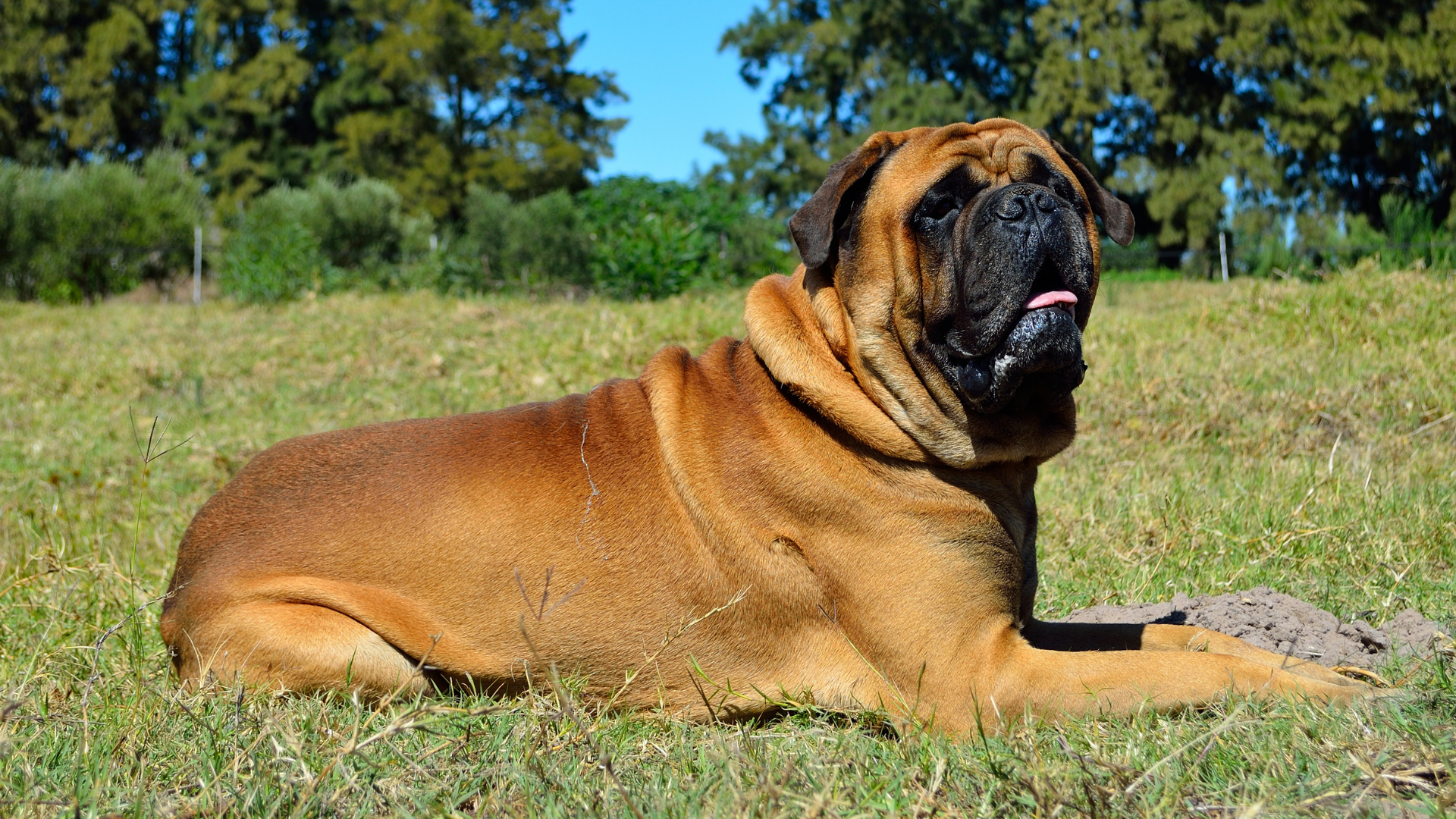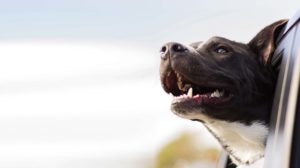History of Bullmastiff
The Bullmastiff was bred in the 1800’s in England by cross breeding Old English Mastiffs and Old English Bulldogs. They were bred as guard dogs to protect estates, particularly from poachers who were prolific at the time. By 1924, the breed was officially recognized by the English Kennel Club.
Appearance and Personality
Bullmastiffs are a large dog ranging from around 60 to 69 cm high at the shoulder and weigh around 40 to 59 kg. Females are usually smaller than the males. They have a limited range of colours which includes fawn and red (and shades thereof), or brindle. The life expectancy of the Bullmastiff is 9 to 10 years. They are a brachycephalic breed, although their face is not as flat as some other breeds such as the French Bulldog.
The Bullmastiff has a short, dense, coat that sheds but is easy to maintain. They can be quite a slobbery dog so keeping a dedicated cloth or wet wipes on hand to keep their faces (and your furniture!) clean could be handy. They do shed moderately, so regular brushing can help keep their coat in good condition and minimise loose hair in the house. Additionally, occasional bathing, regular nail trimming and ear cleaning are necessary for their overall grooming needs.
Intelligent and even-tempered, the Bullmastiff is a devoted companion and guardian. They are good with children but take their large size into consideration as small children can be easily knocked or pulled over. Legacy of their guarding ancestry, they can be aloof with strangers. Some Bullmastiffs can be aggressive toward unfamiliar dogs, so socialisation and obedience training are important early in life. The Bullmastiff needs a moderate amount of daily exercise to stay fit. They will appreciate a backyard to wander around, so are better suited to larger properties. Overall, the Bullmastiff can make a great family pet in a reasonably active household of experienced dog people.
Bullmastiff personality and temperament
Bullmastiffs are famous for being loyal, gentle and affectionate with their families. They can be reserved with strangers and protective of their homes, so it is important to socialise them around lots of people while they are young.
Common Health Concerns
Although the Bullmastiff’s face isn’t as flat as some, it is worth noting that brachycephalic breeds are known for having a higher risk for many major health problems including skin conditions, eye conditions, digestive diseases, and ear infections.
The five most common reasons for Bullmastiffs to visit the vet (excluding routine care visits) according to PetSure data in the 2022 calendar year:
| Rank | Condition | Average cost for single treatment (average pet insurance claim amount) | Highest cost for single treatment (highest pet insurance claim seen for this condition) |
| 1 | Skin condition (infection, allergy, other) | $820 | $9,895 |
| 2 | Ear infection | $299 | $1,364 |
| 3 | Gait Abnormality – Lameness | $572 | $4765 |
| 4 | Cruciate disease | $3,789 | $13,586 |
| 5 | Mass Lesion – Skin | $779 | $3,332 |
Disclaimer: Reimbursement for these claims would be subject to limits, such as annual benefit limits or sub-limits, benefit percentage, applicable waiting periods and any applicable excess. Cover is subject to the policy terms and conditions. You should consider the relevant Product Disclosure Statement or policy wording available from the relevant provider.
For the same period (2022 calendar year), the top five highest single vet treatments (or highest pet insurance claims) for Bullmastiff from PetSure data were:
| Rank | Condition | Highest Cost of treatment for condition (average pet insurance claim amount) |
| 1 | Cruciate Disease | $13,586 |
| 2 | Lymphoma | $12,713 |
| 3 | Hypersensitivity (Allergic) Skin Disorder | $9,895 |
| 4 | Intervertebral Disc Disease | $8,445 |
| 5 | Protein-Losing Enteropathy (PLE) | $8,227 |
Disclaimer: Reimbursement for these claims would be subject to limits, such as annual benefit limits or sub-limits, benefit percentage, applicable waiting periods and any applicable excess. Cover is subject to the policy terms and conditions. You should consider the relevant Product Disclosure Statement or policy wording available from the relevant provider.
Bullmastiff lifespan
Bullmastiffs generally live around 8 to 10 years.
Most popular Bullmastiff names from 2022 PetSure data:
Most popular female names:
- Luna
- Daisy
- Coco
- Bella
- Ruby
- Lola
- Molly
- Winnie
- Willow
- Millie
Most popular male names:
- Teddy
- Milo
- Charlie
- Archie
- Reggie
- Ollie
- Alfie
- Max
- Leo
- Buddy
Frequently Asked Questions
Bullmastiffs were bred in England in the 19th century predominantly as guard dogs to protect gamekeepers’ estates from poachers.
Bullmastiffs are large dogs. On average, males stand around 63-69 cm tall at the shoulder and weigh between 50-59 kg. Females are slightly smaller, typically measuring 61-66 cm in height and weighing 45-54 kg.
Bullmastiffs are famous for being loyal, gentle and affectionate with their families. They can be reserved with strangers and protective of their homes, so it is important to socialise them around lots of people while they are young.
Bullmastiffs are regarded as being good family dogs as they are typically patient and gentle. That said, their large size may make them unsuitable for families with very young children. Always supervise children with dogs.
Although Bullmastiffs are not regarded as overly energetic, but like all dogs they need daily exercise to keep them healthy and prevent boredom. Daily walks and play are usually sufficient for them. They are not well-suited for intense physical activities or prolonged endurance exercises due to their size and potential for joint issues. If it is cold and rainy outside we have some ideas in our ‘5 Fun Ways to Keep Your Pets Active Indoors During Winter‘ article
Bullmastiffs are generally intelligent and trainable. However, they can also be stubborn at times, so consistent and patient training methods work best. Early socialisation and obedience training are important to ensure they grow up to be well-behaved and well-adjusted dogs.
Bullmastiffs can get along well with other pets when they are raised with them and exposed to them from an early age (socialisation). Their protective instincts may sometimes cause them to be wary of unfamiliar animals. It’s important to introduce them to other pets gradually and under controlled circumstances.
Bullmastiffs generally live around 8 to 10 years.
Bullmastiffs have a short dense coat that is relatively easy to maintain. They do shed moderately, so regular brushing can help keep their coat in good condition and minimise loose hair in the house. Additionally, occasional bathing, regular nail trimming and ear cleaning are necessary for their overall grooming needs.
Did you know
Swagger, a 65kg Bullmastiff, was the mascot for the Cleveland Browns, an American professional football team, from 2014 to 2019. He led the team out of the stadium tunnel onto the field before every home game. Swagger died in 2020, at the age of 6, and his son, SJ (Swagger Junior), is the new mascot.
References
- American Kennel Club, Bullmastiff
- Australian National Kennel Council 2021, Breed Standard of the Bullmastiff
- Cleveland Browns 2021, Mascots
Pet insurance can help by covering a portion of the eligible vet bill if the unexpected happens. Because it is difficult to predict the costs of veterinary care, it can help to have measures in place to help prepare for the unexpected. Check out our partner network and explore our policy tools to find a pet insurance policy.
Not all conditions or items are covered by Pet Insurance. Refer to the applicable Product Disclosure Statement for information about coverage and exclusions.








